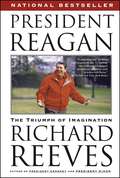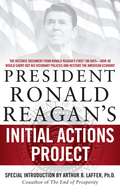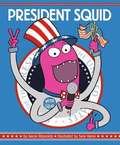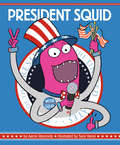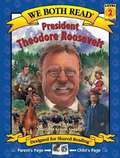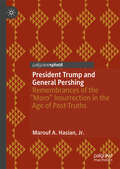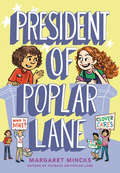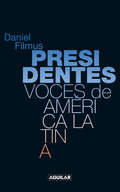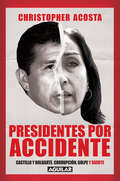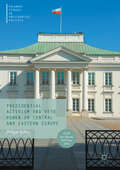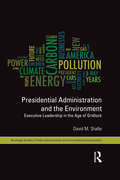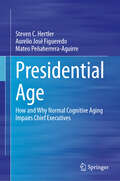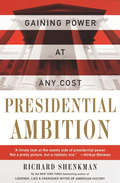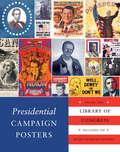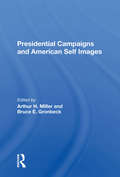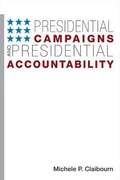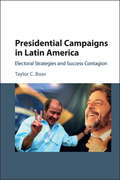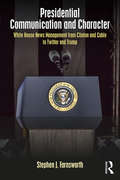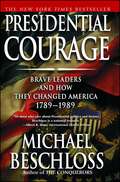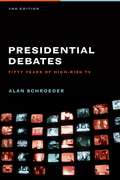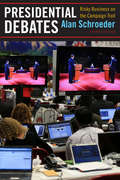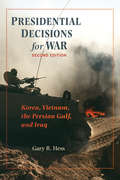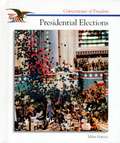- Table View
- List View
President Reagan: The Triumph of Imagination
by Richard ReevesTwenty-five years after Ronald Reagan became president, Richard Reeves has written a surprising and revealing portrait of one of the most important leaders of the twentieth century. As he did in his bestselling books President Kennedy: Profile of Power and President Nixon: Alone in the White House, Reeves has used newly declassified documents and hundreds of interviews to show a president at work day by day, sometimes minute by minute. President Reagan: The Triumph of Imagination is the story of an accomplished politician, a bold, even reckless leader, a gambler, a man who imagined an American past and an American future -- and made them real. He is a man of ideas who changed the world for better or worse, a man who understands that words are often more important than deeds. Reeves shows a man who understands how to be President, who knows that the job is not to manage the government but to lead the nation. In many ways, a quarter of a century later, he is still leading. As his vice president, George H. W. Bush, said after Reagan was shot and hospitalized in 1981: "We will act as if he were here." He is a heroic figure if not always a hero. He did not destroy communism, as his champions claim, but he knew it would self-destruct and hastened the collapse. No small thing. He believed the Soviet Union was evil and he had contempt for the established American policies of containment and détente. Asked about his own Cold War strategy, he answered: "We win. They lose!" Like one of his heroes, Franklin D. Roosevelt, he has become larger than life. As Roosevelt became an icon central to American liberalism, Reagan became the nucleus holding together American conservatism. He is the only president whose name became a political creed, a noun not an adjective: "Reaganism." Reagan's ideas were so old they seemed new. He preached an individualism, inspiring and cruel, that isolated and shamed the halt and the lame. He dumbed-down America, brilliantly blending fact and fiction, transforming political debate into emotion-driven entertainment. He recklessly mortgaged America with uncontrolled military spending, less taxation, and more debt. In focusing on the key moments of the Reagan presidency, Reeves recounts the amazing resiliency of Ronald Reagan, the real "comeback kid." Here is a seventy-year-old man coming back from a near-fatal gunshot wound, from cancer, from the worst recession in American history. Then, in personal despair as his administration was shredded by the lying and secrets of hidden wars and double-dealing, he was able to forge one of history's amazing relationships with the leader of "the Evil Empire." That story is told for the first time using the transcripts of the Reagan-Gorbachev meetings, the climax of an epic story -- as if he were here.
President Ronald Reagan's Initial Actions Project
by Arthur B. Laffer White House StaffWhen Ronald Reagan took office, he was facing an economic downturn similar to the one our country is currently experiencing. Key members of Reagan’s staff prepared an Initial Actions Project, which takes every branch of government, including Congress, into consideration, and offers a clear and concise blueprint of how Reagan’s economic policies were achieved. As a model for President Obama, who is dealing with the daunting demands of a nation in turmoil, the significance of this report has never been more timely. History proves that President Reagan’s policies led to economic growth; will President Obama overturn this invaluable legacy? Only time—and history—will tell. Featuring a special Introduction by Arthur B. Laffer, who also worked in the Reagan White House, President Ronald Reagan’s Initial Actions Project puts the IAP action plan in perspective and provides valuable insight into the most important economic issues of our time.
President Squid
by Aaron Reynolds Sara VaronJoin Aaron Reynolds and Sara Varon as they explore the ideal qualities of leaders, diplomats...and giant squid. Squid knows all about being president. It means living in a big house, doing all the talking--oh, and having a tie is crucial. He's all set! In the next election, make a more informed choice. Vote for President Squid!
President Squid
by Aaron ReynoldsJoin Aaron Reynolds and Sara Varon as they explore the ideal qualities of leaders, diplomats...and giant squid. Squid knows all about being president. It means living in a big house, doing all the talking—oh, and having a tie is crucial. He's all set! In the next election, make a more informed choice. Vote for President Squid!And this is the fixed-format version, which looks almost identical to the print edition!
President Theodore Roosevelt (We Both Read)
by Sindy MckayA perfect book about our 26th President for young readers! The book covers his life and many accomplishments, demonstrating how, through hard work and dedication, he helped to make the United States a better country for all of us.
President Trump and General Pershing: Remembrances of the “Moro” Insurrection in the Age of Post-Truths
by Marouf A. Hasian Jr.This book provides a critical analysis of Donald Trump’s mention of General Pershing and his alleged use of bullets dipped in pig’s blood to kill 49 out of 50 captured Muslims during the suppression years in the Philippines. The author argues that most observers who heard this “fable” dismissed it as an inaccurate representation of historical realities that also maligned a great general. Using critiques of both Trump and “post-truths,” the author argues that instead of being summarily dismissive of these comments, academics, investigative journalists and others ought to follow the US president’s admonition that we study “history,” but do so in nuanced ways. The author argues that there are times when false renditions of historical events may in fact provide opportunities to revisit contentious pasts, and this book suggests that in place of sanitized military histories, we take this opportunity to provide detailed analyses of the “Moro” rebellion.
President of Poplar Lane
by Margaret MincksThe Poplar Kids are taking over their middle school in this uproariously funny sequel to Payback on Poplar Lane, which NYT bestselling author Chris Grabenstein called "the funniest book I've read in years."Clover O'Reilly is super psyched to run for class president. As the second oldest of five sisters, she struggles to be heard in her ginormous family. But when you are president of the seventh grade, everyone has listen to you! Comedy magician Mike the Unusual feels confident onstage. Offstage, life can be tricky. It's okay that his classmates don't understand him, but it bugs him when his dad suggests he needs more friends. Is he willing to give up his passion to win friends . . . and votes?Clover and Mike compete to rule their school in this sequel to Payback on Poplar Lane that's filled with scheming advisers, political gaffes, missteps that lead to big laughs... and campaign sabotage!
President without a Party: The Life of John Tyler
by Christopher J. LeahyHistorians have long viewed President John Tyler as one of the nation’s least effective heads of state. In President without a Party—the first full-scale biography of Tyler in more than fifty years and the first new academic study of him in eight decades—Christopher J. Leahy explores the life of the tenth chief executive of the United States. Born in the Virginia Tidewater into an elite family sympathetic to the ideals of the American Revolution, Tyler, like his father, worked as an attorney before entering politics. Leahy uses a wealth of primary source materials to chart Tyler’s early political path, from his election to the Virginia legislature in 1811, through his stints as a congressman and senator, to his vice-presidential nomination on the Whig ticket for the campaign of 1840. When William Henry Harrison died unexpectedly a mere month after assuming the presidency, Tyler became the first vice president to become president because of the death of the incumbent. Leahy traces Tyler’s ascent to the highest office in the land and unpacks the fraught dynamics between Tyler and his fellow Whigs, who ultimately banished the beleaguered president from their ranks and stymied his election bid three years later. Leahy also examines the president’s personal life, especially his relationships with his wives and children. In the end, Leahy suggests, politics fulfilled Tyler the most, often to the detriment of his family. Such was true even after his presidency, when Virginians elected him to the Confederate Congress in 1861, and northerners and Unionists branded him a “traitor president.” The most complete accounting of Tyler’s life and career, Leahy’s biography makes an original contribution to the fields of politics, family life, and slavery in the antebellum South. Moving beyond the standard, often shortsighted studies that describe Tyler as simply a defender of the Old South’s dominant ideology of states’ rights and strict construction of the Constitution, Leahy offers a nuanced portrayal of a president who favored a middle-of-the-road, bipartisan approach to the nation’s problems. This strategy did not make Tyler popular with either the Whigs or the opposition Democrats while he was in office, or with historians and biographers ever since. Moreover, his most significant achievement as president—the annexation of Texas—exacerbated sectional tensions and put the United States on the road to civil war.
Presidentes
by Daniel FilmusPresidentes es una postal de época, o un álbum de muchas postales. Se trata de imágenes que pueden verse en el presente, que tienen memoria, y que, sobre todo, buscan dejar huella en el futuro. En Presidentes, Daniel Filmus narra sus encuentros con once mandatarios de la región, y logra que hablen con naturalidad de temas alejados de la coyuntura. La infancia, la familia, la llegada a la política y sus sueños personales se mezclan con la visión de cada uno sobre el futuro de la integración entre los países. La larga década neoliberal dejó huellas imborrables en la constitución de las identidades de América Latina. Sin embargo, también permitió la aparición de movimientos de renovación. En la actualidad, muchos de los presidentes de los países de la región representan esa noción de cambio, y tienen características únicas. La presidenta argentina, Cristina Fernández, mencionó en más de una ocasión que es la primera vez que los gobernantes se parecen tanto a las sociedades que los eligieron. Presidentes es una postal de época, o un álbum de muchas postales. Se trata de imágenes que pueden verse en el presente, que tienen memoria, y que, sobre todo, buscan dejar huella en el futuro.
Presidentes por accidente: Castillo y Boluarte. Corrupción, golpe y suerte
by Christopher AcostaEL MEJOR PERIODISTA DE INVESTIGACIÓN TRAS LA HUELLA DEL ACCIDENTE QUE LLEVÓ A PEDRO CASTILLO Y DINA BOLUARTE A LA PRESIDENCIA Si a Pedro Castillo lo conocíamos poco, a Dina Boluarte, menos. ¿Quién es la mujer que, tras un fallido golpe de Estado, asume el poder del país? ¿Quién el hombre que intenta retenerlo, convencido de una traición de quien lo sucede? Presidentes por accidente, la nueva investigación periodística de Christopher Acosta -autor del bestseller Plata como cancha-, nos revela detalles hasta ahora desconocidos, no solo de las biografías y las personalidades de Castillo y Boluarte, sino de cómo estas explican las controvertidas decisiones que adoptaron tras colocarse la banda presidencial. Boluarte llega a la presidencia ahorrándose aquello que más temen los candidatos de una campaña electoral: el escrutinio de sus actos públicos y sus vidas privadas. Este libro llena ese vacío. Acorralado por las investigaciones en su contra, Castillo cierra su paso por el Gobierno con un número temerario y espectacular: el de un clavadista que se lanza a una piscina que sabe sin agua. Pero ¿son en verdad ambos personajes tan diferentes como se presentan? Estas páginas delinean el doble perfil de nuestros dos últimos presidentes, pero son también una apasionante crónica política colmada de intrigas, traiciones y corrupción. Una historia que demuestra que para Castillo y Boluarte la presidencia es algo que les sucede: un acontecimiento en sus vidas.
Presidential Activism and Veto Power in Central and Eastern Europe (Palgrave Studies in Presidential Politics)
by Philipp KökerThis book examines the use of presidential powers in Central and East Europe between 1990 and 2010. Focussing on presidential vetoes and the formation of governments, it maps patterns of presidential activism and its determinants across nine democracies. Thereby, it combines the analysis of original quantitative data on the use of presidential powers with in-depth case studies in an innovative mixed-methods framework. Based on regression analyses and unique insights from numerous elite interviews, the study shows strong support for the hitherto insufficiently tested assumption that popularly elected presidents are more active than their indirectly elected counterparts. As one of the first comprehensive comparative studies of presidential activism and veto power in Europe, this book will be a key resource not only for area specialists but also for scholars of presidential studies, comparative government, and executives.
Presidential Administration and the Environment: Executive Leadership in the Age of Gridlock (Routledge Studies in Public Administration and Environmental Sustainability)
by David M. ShafieAfter sweeping environmental legislation passed in the 1970s and 1980s, the 1990s ushered in an era when new legislation and reforms to existing laws were consistently caught up in a gridlock. In response, environmental groups became more specialized and professional, learning how to effect policy change through the courts, states, and federal agencies rather than through grassroots movements. Without a significantly mobilized public and with a generally uncooperative Congress, presidents since the 1990s have been forced to step into a new role of increasing presidential dominance over environmental policies. Rather than working with Congress, presidents instead have employed unilateral actions and administrative strategies to further their environmental goals. Presidential Administration and the Environment offers a detailed examination of the strategies and tools used by U.S. presidents. Using primary sources from presidential libraries such as speeches and staff communications, David M. Shafie analyzes how presidents such as Bill Clinton and George W. Bush have used alternative executive approaches to pass environmental policies. From there, Shafie presents case studies in land management, water policy, toxics, and climate change. He analyzes the role that executive leadership has played in passing policies within these four areas, explains how this role has changed over time, and concludes by investigating how Obama’s policies compare thus far with those of his predecessors. Shafie’s combination of qualitative content analysis and topical case studies offers scholars and researchers alike important insights for understanding the interactions between environmental groups and the executive branch and the implications for future policymaking in the United States.
Presidential Age: How and Why Normal Cognitive Aging Impairs Chief Executives
by Steven C. Hertler Aurelio José Figueredo Mateo Peñaherrera-AguirreThis book on presidential age is not about Alzheimer's Disease and associated pathologies of the aging brain. It is instead about the normally aging brain. Brains don’t simply develop and maintain their functionality into older adulthood unless otherwise impaired by neurocognitive disease. Were this the case, this book might be about leveraging prodromal biomarkers of neurodegenerative diseases to screen prospective presidential candidates. Instead, the normal decline age brings to all human brains begs a different type of book—and a broader and more blanketed warning about electing increasingly older presidents.
Presidential Ambition
by Richard ShenkmanIn this timely, illuminating, and often shocking book, Richard Shenkman reveals that it is not just recent presidents but all presidents who have been ambitious--and at times frighteningly so, willing to sacrifice their health, family, loyalty, and values. Presidential Ambition is a book that will permanently alter the way we think about past, present, and future American presidents.
Presidential Campaign Posters: Two Hundred Years of Election Art
by The Library Of CongressHere are 100 ready-to-frame political campaign posters from the annals of American history! The candidates range from Andrew Jackson ("Defender of Beauty and Booty") and William Henry Harrison ("Have Some Hard Cider!") to Richard Nixon ("He's the One!"), Barack Obama ("Hope"), and many, many more. The posters are backed with colorful historical commentary and additional artwork; best of all, they're bound with clean microperforated edges so they can be removed, framed, and displayed. Presidential Campaign Posters is the perfect gift for political junkies of all ages!
Presidential Campaigns And American Self Images
by Bruce E Gronbeck Arthur H MillerThis volume explores a central political paradox: why American scholars, journalists, and citizens periodically question the viability of their presidential electoral system and yet believe that presidential elections are our best hope for tomorrow. The book argues that the key to understanding this paradox lies in the concept of "self-image," exploring relationships between campaign activities and political culture. After presenting an introduction to the history of presidential campaigning and a theory of political image, the book arranges essays in three parts: images centered on candidates, mass media, and the public. A final essay assesses explanations of the contrasts between the 1988 and 1992elections and suggests tomorrow's research agenda.
Presidential Campaigns and Presidential Accountability
by Michele P. ClaibournIn investigating the presidential campaigns and early administrations of Barack Obama, George W. Bush, and Bill Clinton, Presidential Campaigns and Presidential Accountability shows how campaign promises are realized in government once the victor is established in the Oval Office. To measure correlations between presidential campaigns and policy-making, Michele P. Claibourn closely examines detailed campaign advertising information, survey data about citizen's responses to campaigns, processes that create expectations among constituents, and media attention and response to candidates. Disputing the notion that presidents ignore campaign issues upon being elected, Presidential Campaigns and Presidential Accountability contends that candidates raise issues that matter and develop ideas to address these issues based on voter reactions. Conventional disappointment in presidential campaigns stems from a misunderstanding of the role that presidents play in a system of separate institutions sharing power, and Claibourn forces us to think about presidential campaigns in the context of the presidency--what the president realistically can and cannot do. Based on comparisons of the Clinton, Bush, and Obama campaigns and the first years of the subsequent presidential administrations, Claibourn builds a generalized theory of agenda accountability, showing how presidential action is constrained by campaign agendas.
Presidential Campaigns in Latin America: Electoral Strategies And Success Contagion
by Boas Taylor C.How do presidential candidates in new democracies choose their campaign strategies, and what strategies do they adopt? In contrast to the claim that campaigns around the world are becoming more similar to one another, Taylor Boas argues that new democracies are likely to develop nationally specific approaches to electioneering through a process called success contagion. The theory of success contagion holds that the first elected president to complete a successful term in office establishes a national model of campaign strategy that other candidates will adopt in the future. He develops this argument for the cases of Chile, Brazil, and Peru, drawing on interviews with campaign strategists and content analysis of candidates' television advertising from the 1980s through 2011. The author concludes by testing the argument in ten other new democracies around the world, demonstrating substantial support for the theory.
Presidential Communication and Character: White House News Management from Clinton and Cable to Twitter and Trump
by Stephen J. FarnsworthThis book traces the evolution of White House news management during America’s changing media environment over the past two decades. Comparing and contrasting the communication strategies of Bill Clinton, George W. Bush, Barack Obama, and Donald Trump, it demonstrates the difficulty that all presidents have in controlling their messages despite a seemingly endless array of new media outlets and the great advantages of the office. That difficulty is compounded by new media’s amplification of presidential character traits for good or ill. Facebook, Twitter, and YouTube notwithstanding, presidential power still resides in the "power to persuade," and that task remains a steep challenge. More than ever, presidential character matters, and the media presidents now employ report on the messenger as much as the message. The book also looks at the media strategies of candidates during the 2016 presidential campaign, puts presidential media use in global context, and covers the early phase of the Trump administration, the first true Twitter presidency.
Presidential Courage: Brave Leaders and How They Changed America 1789-1989
by Michael R. BeschlossFrom the acclaimed bestselling author of The Conquerors Michael Beschloss has brought us a brilliantly readable and inspiring saga about crucial times in America's history when a courageous President dramatically changed the future of the United States. With surprising new sources and a dazzling command of history and human character, Beschloss brings to life these flawed, complex men -- and their wives, families, friends and foes. Never have we had a more intimate, behind-the-scenes view of Presidents coping with the supreme dilemmas of their lives. You will be in the room with the private George Washington, braving threats of impeachment and assassination to make peace with England. John Adams, incurring his party's "unrelenting hatred" by refusing to fight France and warning his enemies, "Great is the guilt of an unnecessary war." Andrew Jackson, in a death struggle against the corrupt Bank of the United States. Abraham Lincoln, risking his Presidency to insist that slaves be freed. Beschloss also shows us Theodore Roosevelt, taunting J. P. Morgan and the Wall Street leaders who dominated his party. Franklin Roosevelt, defying the isolationists -- and maybe the law -- to stop Adolf Hitler. Harry Truman, risking a walkout by top officials to recognize a Jewish state. John Kennedy, the belated champion of civil rights, complaining that he has cost himself a second term. And finally, two hundred years after Washington, Ronald Reagan, irking some of his oldest backers to seek an end to the Cold War. As Beschloss shows in this gripping and important book, none of these Presidents was eager to incur ridicule, vilification or threats of political destruction and even assassination. But in the end, bolstered by friends and family, hidden private beliefs and, sometimes, religious faith, each ultimately proved himself to be, in Andrew Jackson's words, "born for the storm."
Presidential Debates: Fifty Years of High-Risk TV
by Alan SchroederAlan Schroeder's popular history now covers the 2000 Bush-Gore and 2004 Bush-Kerry debates, including innovations in format and press coverage, and adds new research on televised debates since 1960. Schroeder organizes his book according to a television production timeline, highlighting the importance of pre- and postdebate periods, as well as the live telecasts themselves. He describes production in painstaking detail, from the selection of questioners to camera angles, from makeup to lighting and set design. Televised debates represent a rare departure from well-choreographed campaigns, and new media such as YouTube continue to reshape form and content. Conducting interviews with journalists and industry insiders, and drawing on his own experience as an award-winning reporter and television producer, Schroeder delivers a fascinating backstage tour of every aspect of debate performance.
Presidential Debates: Risky Business on the Campaign Trail
by Alan SchroederAlan Schroeder's big-picture history recounts the phenomenon of American televised presidential debates and its evolution over the past half century. From pundits to political operatives, from debate moderators to the viewing public, Presidential Debates reveals how the various stakeholders make and experience this powerful event. For this third edition, Schroeder analyzes the presidential debates of 2008 and 2012 and the crucial role that social media and contemporary news outlets had in shaping their design and reception. He also expands his coverage of previous campaigns, including the landmark meetings in 1960 between John F. Kennedy and Richard Nixon. Schroeder details an insider's view of the key phases of the debate: anticipation, in which the campaigns negotiate rules, formulate strategy, and steer press coverage; execution, in which the candidates, moderators, panelists, and television professionals create and project the event; and reaction, in which the commentators, spin doctors, and viewers evaluate the performance and move story lines in new directions. New chapters focus on real-time debate responses and the extent to which postdebate news coverage influences voters' decision making and candidates' behavior.
Presidential Decisions for War: Korea, Vietnam, the Persian Gulf, and Iraq (The American Moment)
by Gary R. HessFollowing World War II, Americans expected that the United States would wage another major war against a superpower. Instead, the nation has fought limited wars against much weaker states, such as North Korea, North Vietnam, and Iraq. This revised and updated edition of Presidential Decisions for War analyzes the means by which four presidents have taken the nation to war and assesses the effectiveness of each president's leadership during those conflicts. Gary Hess recreates the unfolding crises in Korea, Vietnam, and Iraq to probe the reasons why Presidents Truman, Johnson, George H. W. Bush, and George W. Bush and their advisors decided in favor of war. He compares the performance of the commanders-in-chief and evaluates how effectively each understood U.S. interests, explored alternatives to war, adhered to constitutional processes, and built congressional, popular, and international support. A new conclusion points out, that unlike the administrations of Truman, Johnson, and the elder Bush, George W. Bush's White House actively sought to change the international order through preemptive war and aggressive democracy building. Fully revised and featuring an examination of how each of the presidents learned from history and juggled the demands on diplomacy, this comparative study of presidential war-making elucidates how effective executive leadership—or its absence—directly affects the outcome of wars.
Presidential Decrees in Russia
by Thomas F. RemingtonThe book examines the way Russian presidents Yeltsin, Medvedev, and Putin have used their constitutional decree powers since the end of the Soviet regime. The Russian constitution gives the Russian president extremely broad decree-making power, but its exercise is constrained by both formal and informal considerations. The book compares the Russian president's powers to those of other presidents, including the executive powers of the United States president and those of Latin American presidents. The book traces the historical development of decree power in Russia from the first constitution in 1905 through the Soviet period and up to the present day, showing strong continuities over time. It concludes that Russia's president operates in a strategic environment, where he must anticipate the way other actors, such as the bureaucracy and the parliament, will respond to his use of decree power.
Presidential Elections (Cornerstones of Freedom)
by Miles HarveyExamines how presidential elections have changed over the past 200 years, discussing topics such as primaries, national conventions, television campaigns, and funding.
